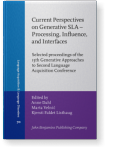References
Chomsky, N. (1981). Lectures on government and binding. Foris.
Chomsky, N. (2001). Derivation by phase. In M. Kenstowicz1 (Ed.), Ken Hale: A Life in language (pp. 1–52). The MIT Press. 

Cinque, G. (1999). Adverbs and functional heads: A cross-linguistic perspective. Oxford University Press. 

Clements, G. (1975). The logophoric pronoun in Ewe: Its role in discourse. Journal of West African Languages, 10(2), 141–177. 

Cole, P., Hermon, G., & Sung, L.-M. (1990). Principle and parameters of long-distance reflexives. Linguistic Inquiry, 21(1), 1–22. [URL]
Hasegawa, N. (2008). Licensing a null subject at CP: Imperatives, the 1st person, and PRO. Scientific approaches to language, No.7 (pp. 1–34). Center for Language Sciences, Kanda University of International Studies.
Hasegawa, N. (2009). Agreement at the CP level: Clause types and the ‘person’ restrictions on the subject. In R. Shibagaki & R. Vermeulen (Eds.), The proceedings of the Workshop on Altaic Formal Linguistics 5 (pp. 131–152). The MIT Press.
Holmberg, A. (2005). Is there a little pro? Evidence from Finnish. Linguistic Inquiry, 36, 533–564. [URL]. 

Huang, C.-T. J., Huang, Y.-H., Teng, T.-H., & Tiedeman, R. (1984). Reflexives in Chinese and the teaching of Chinese. Proceedings of the First World Conference on Chinese Language (pp. 205–215). World Chinese Language Association, Taipei.
Huang, C.-T. J. (1984). On the distribution and reference of empty pronouns. Linguistic Inquiry, 15(4), 531–574. [URL]
Iida, M. (1996). Context and binding in Japanese. SCLI.
Jimenez-Fermandez, A. L. & Miyagawa, S. (2010). Discourse-agreement features, phrasal C and the edge: A minimalist approach. Diacritica-Ciencias da Linguagerm, 23, 23–46.
Kano, A. & Nakayama, N. (2004). Knowledge of binding and the role of empathy in interpreting anaphora among adult second-language learners. Studies in Language Sciences, 6, 169–184.
Katada, F. (1991). The LF representation of anaphors. Linguistic Inquiry, 22(2), 287–313. [URL]
Kayne, R. (2005). Some notes on comparative syntax, with special reference to English and French. In G. Cinque & R. Kayne (Eds.), The Oxford handbook of comparative syntax (pp. 3–69). Oxford University Press.
Kishida, M. (2011). Reflexives in Japanese (Unpublished doctoral dissertation). University of Maryland.
Kiss, K. (1995). Introduction. In K. Kiss (Ed.), Discourse configurational languages (pp. 3–27). Oxford University Press. 

Kizu, M. (2013). L2 acquisition of null subjects in Japanese: A new generative perspective and its pedagogical implications. In M. Whong, G. Kook-Hee, & H. Marsden (Eds.), Universal Grammar and the second language classroom (pp. 35–55). Springer. 

Kizu, M. (2020). Nihongo no syusetsu gensyo ni kansuru daini gengo syutoku kenkyu [Main clause phenomena in L2 Japanese acquisition research]. In T. Shirahata & K. Suda (Eds.), Daini genngo syutokukenkyu no Hakyu kouka [Second language research and its application] (pp. 57–86). Kuroshio.
Kizu, M., & Yamada, K. (2018). Acquisition of person restriction on subjects in Japanese as a second language. J-SLA 2018, oral presentation (in Japanese). Gakushuin University, Tokyo.
Kuno, S. (1972). Pronominalizations, reflexivization, and direct discourse. Linguistic Inquiry, 3(2), 161–95. [URL]
Kuno, S. & Kaburaki, E. (1977). Empathy and syntax. Linguistic Inquiry, 8(4), 625–672. [URL]
Kuroda, S.-Y. (1973). On Kuno’s direct discourse analysis of the Japanese reflexive zibun. Papers in Japanese Linguistics, 2, 136–147. 

Liu, C-M. (2014). A modular theory of radical pro drop (Unpublished doctoral dissertation). Harvard University.
Maki, H., Dunton, J., & Obringer, C. (2003). What grade would I be in if I were Japanese? Bulletin of the Faculty of Regional Studies, 12, 109–118. Gifu University.
Miyagawa, S. (2005). On the EPP. In M. McGinnis & N. Richards (Eds.), Perspectives on phases (pp. 201–235). MITWPL.
Miyagawa, S. (2009). Why agree? Why move? Unifying agreement-based and discourse configurational languages. The MIT Press. 

Miyagawa, S. (2017). Agreement beyond phi. The MIT Press. 

Nawata, H., & Tsubokura, K. (2010). On the resetting of the subject parameter by Japanese learners of English: A survey of junior high school students. Second Language, 9, 63–82. 

Nishigauchi, T. (2014). Reflexive binding: Awareness and empathy from a syntactic point of view. Journal of East Asian Linguistics, 23(2), 157–206. 

Oshima, D. Y. (2004). Zibun revisited: Empathy, logophoricity, and binding. University of Washington Working Papers in Linguistics, 23, 175–190.
Pan, H. (2001). Why the blocking effect? In P. Cole, J. Huang, & G. Hermon (Eds.), Long-distance reflexives (pp. 279–316). Academic Press.
Progovac, L. (1992). Relativized SUBJECT: Long distance reflexives without movement. Linguistic Inquiry, 23(4), 671–680. [URL]
Progovac, L. (1993). Long-distance reflexives: Movement to Infl versus relativized SUBJECT. Linguistic Inquiry, 24(4), 755–772. [URL]
Schwartz, B. D., & Sprouse, R. A. (1996). L2 cognitive states and the Full Transfer/Full Access model. Second Language Research, 12(1), 40–72. 

Sorace, A., & Filiaci, F. (2006). Anaphora resolution in near-native speakers of Italian. Second Language Research, 22, 339–368. 

Tang, C. (1989). Chinese reflexives. Natural Language and Linguistics Theory, 7(1), 93–121. 

Tenny, C. (2006). Evidentiality, experiencers, and the syntax of sentience in Japanese. Journal of East Asian Linguistics, 15, 245–288. 

Thomas, M. (1989). The interpretation of English reflexive pronouns by non-native speakers. Studies in Second Language Acquisition, 11(3), 281–303. 

Umeda, M., Takeda, K., Hirakawa, M., Fukuda, M., Hirakawa, Y., Matthews, J., & Snape, N. (2017). Acquiring antecedents for reflexives when both L1 and L2 permit long-distance binding. Journal of the European Second Language Association, 1(1), 38–48. 

Umeda, M., Hirakawa, M., Suzuki, K., Takeda, K., Fukuda, M., Matthews, J., and Snape, N. (2022). The blocking effect in the acquisition of Chinese reflexive ziji by L1-Japanese learners. The Japan Society for Language Sciences, The 23rd Annual International Conference, September 25, 2022.
Van Urk, Koppe. (2015). A uniform syntax for phrasal movement: A case study of Dinka Bor (Unpublished doctoral dissertation). MIT.
Yang, C.-Y. B. (2014). Chinese null subjects: A view from the top. In C.-T. J. Huang & L. Feng-hsi (Eds.), Peaches and plums (pp. 227–253). Institute of Linguistics, Academia Sinica, Taipei.
Yoshimura, N., Nakayama, M., Shirahata, T., Sawasaki, K., & Terao, Y. (2012). Zibun and locality in L2 Japanese. Journal of Japanese Linguistics, 28, 89–110. 

Yuan, B. (1998). Interpretation of binding and orientation of the Chinese reflexive ziji by English and Japanese speakers. Second Language Research, 14, 324–240.
